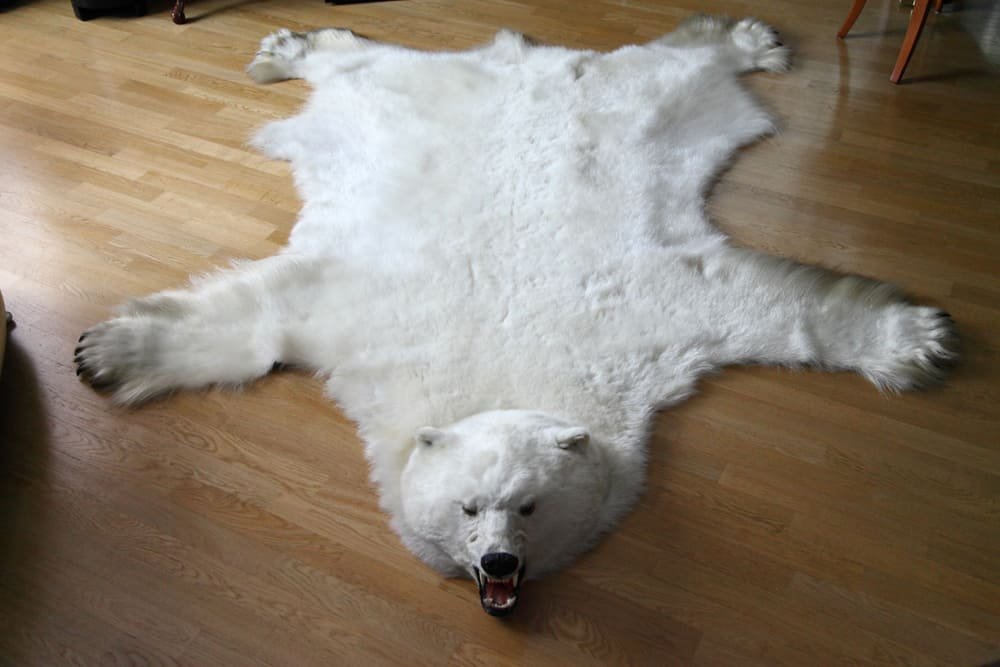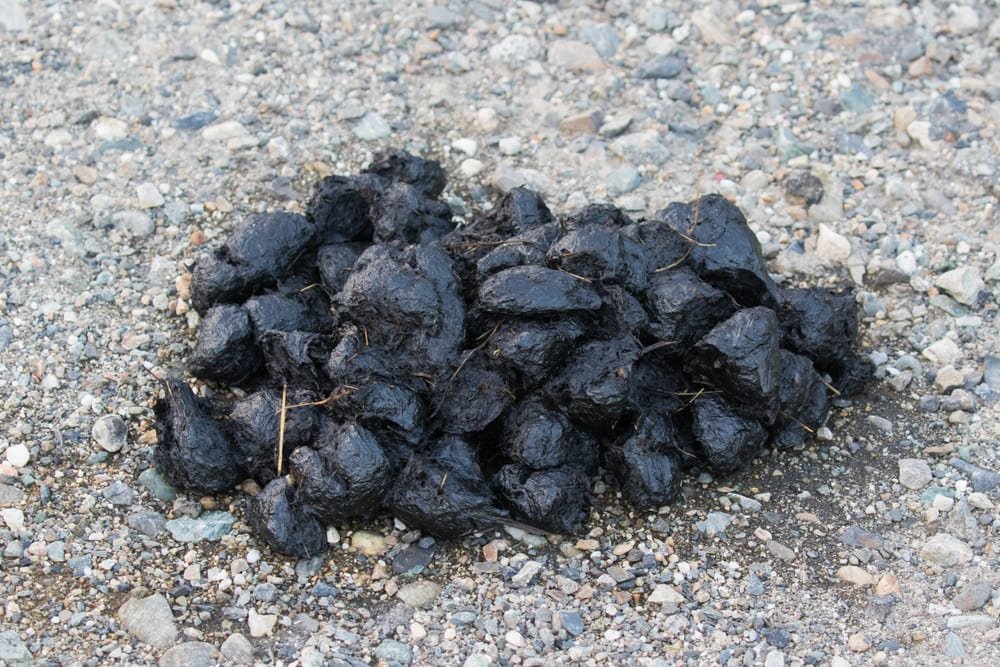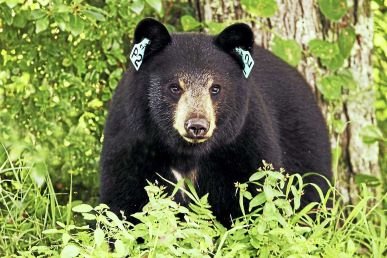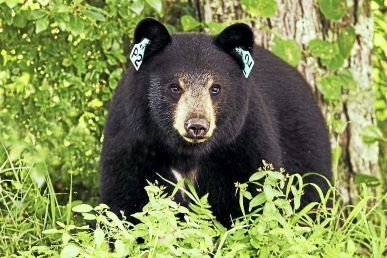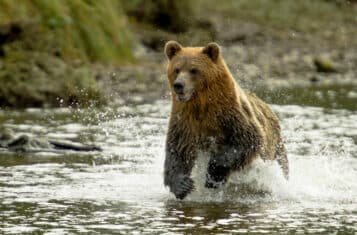The forest floor tells a story – one of massive creatures moving silently through the wilderness. But can you read it?

In the bear hunting and wildlife tracking world, few things are as thrilling – or as crucial – as discovering a fresh bear paw print in the wild. These impressions in the earth are more than just marks; they’re a window into the hidden world of one of nature’s most formidable predators.
As an experienced hunter and lifelong student of the wild, I’ve realized that understanding bear paw prints is an art form that can mean the difference between a successful hunt and a fruitless trek through the backcountry.
Whether you’re a seasoned hunter looking to refine your skills, a wildlife enthusiast eager to interpret the signs of nature, or a novice taking your first steps into the world of animal tracking, mastering the nuances of bear paw print identification is an invaluable skill.
In this comprehensive guide, we’ll delve deep into the world of bear tracks. We’ll explore how to distinguish between different bear species solely by their paw prints, uncover the secrets these marks can reveal about a bear’s size and behavior, and learn how to use this knowledge to track these elusive giants through their natural habitat.
So grab your tracking journal and lace up your boots – we’re about to embark on a journey that will forever change the way you see the forest floor. Let’s learn to read the story that bear paw prints have to tell.
Understanding Bear Paw Prints: The Basics
Let’s face it – it’s pretty exciting the first time you see a real bear paw print in the wild! I remember my first time like it was yesterday. My heart was racing, and I couldn’t believe how big it was!
But here’s the thing: not all bear prints are the same. Similar to how your hands and feet differ, bears have different prints for their front and back paws. Cool, right?
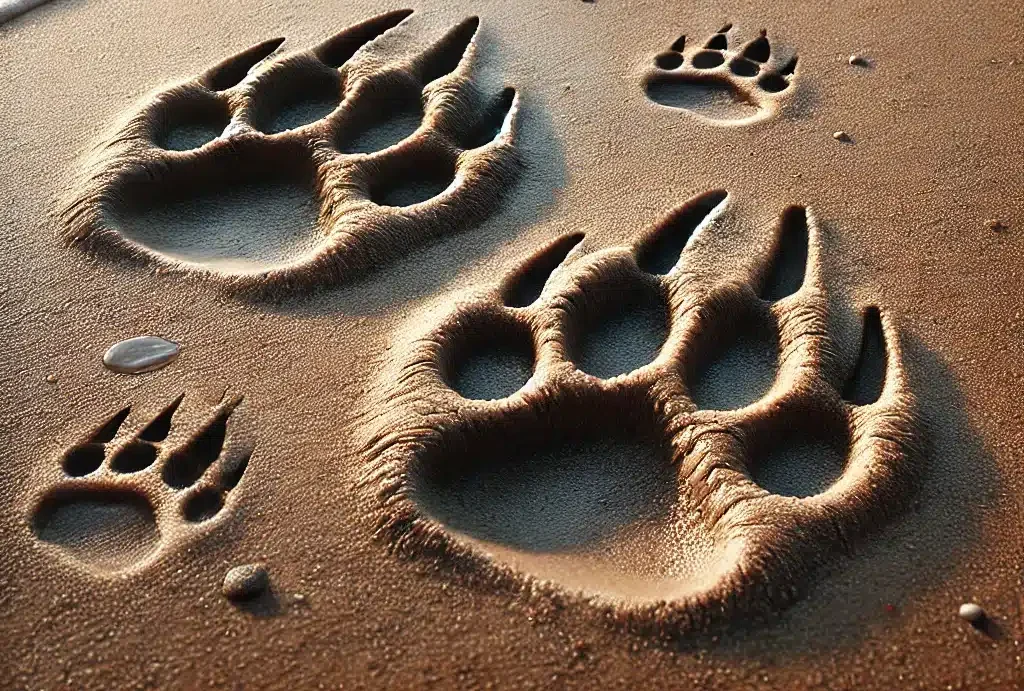
Front Paw Prints: Think of a bear’s front paw like a big, furry hand. The print it leaves looks kind of like a human handprint, but way bigger and with claws. Here’s what to look for:
- A wide palm pad (that’s the big part at the bottom)
- Five toes spread out in a curve above the palm
- Claw marks that show up as little dots or lines in front of the toes
Back Paw Prints: A bear’s back paw resembles a long, flat foot. The print it makes is pretty different from the front paw. Here’s what you’ll see:
- A long, skinny heel pad
- Five toes that are more bunched together
- Claw marks that might not always show up clearly
Here’s a fun fact: bears walk a bit like we do, putting one foot in front of the other. This makes a zigzag pattern of prints that we call a trail.
Size Matters: Bear prints can be tiny (like a big dog’s paw) or massive (bigger than your head!). It all depends on how old and big the bear is.
I once saw a print so big I could fit both hands in it with room to spare! It was from a huge grizzly bear. But don’t worry—most bear prints aren’t that scary big.
Practice Makes Perfect: Learning to spot these details takes time. Don’t get frustrated if you can’t tell immediately – even expert trackers had to start somewhere!
I mixed up a big dog print with a bear print when I started. Boy, was I embarrassed when my dad pointed out the difference! But that’s how we learn.
Try looking for animal tracks next time you’re out in the woods. Even if they’re not bear prints, it’s great practice. And who knows? Maybe you’ll spot your first real bear paw print and get that same thrill I did all those years ago!
Identifying Bear Species by Their Paw Prints
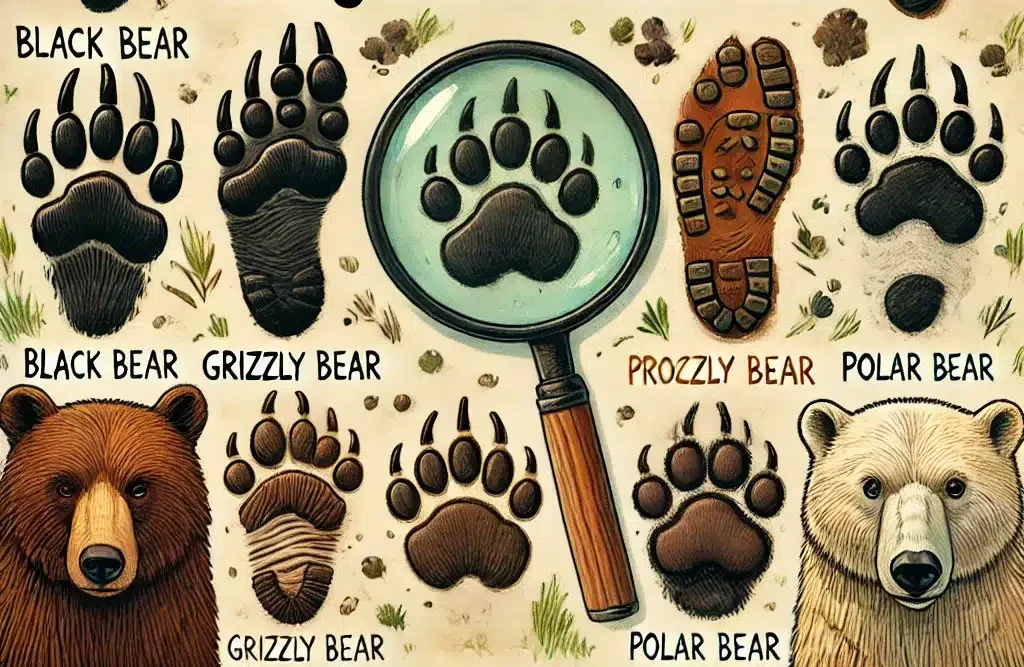
Imagine you’re walking in the woods, and you spot a bear print. Exciting, right? But what kind of bear made it? Let’s break it down:
Black Bear Prints: Black bears are the most common bears in North America. Here’s what their prints look like:
- Smaller than other bears (about 5-7 inches long for an adult)
- Front paw prints are wider than they are long
- The claws don’t usually show up very well in the print
- The toes make a nice curve at the top of the print
Fun fact: Despite their name, black bears can be brown, cinnamon, or even white!
Grizzly Bear Prints: Grizzlies are the big guys of the bear world. Their prints are:
- Bigger than black bears (about 6-12 inches long for an adult)
- More square-shaped overall
- The claws appear well, often leaving long marks (up to 4 inches!)
- The toes are more spread out than a black bear’s
I once saw a grizzly print so fresh I could see the texture of the bear’s paw pad in the mud. It was like the bear was right there!
Polar Bear Prints: You might see polar bear prints if you’re way north. They’re pretty special:
- Huge! They can be up to 12 inches long and 10 inches wide
- The very round overall shape
- Big, fuzzy toe pads that often blur together in the print
- You might see fur marks around the print
Polar bears have furry feet to help them walk on ice. How cool is that?
A Word of Caution: Remember, where there are fresh bear prints, there might be a bear nearby. Always be safe and alert when you’re in bear country!
Mixing It Up: Sometimes, bears can fool us. Young grizzlies might leave prints that look like adult black bears, and really big black bears can leave prints almost as big as a small grizzly’s.
That’s why looking at all the clues is important – not just size but shape, claw marks, and where you are. In some places, you might only have one kind of bear, which makes it easier!
Practice Time: Try to spot some animal tracks next time you’re out hiking or camping. Even if they’re not bear prints, it’s good practice. You might see deer, raccoon, or even mountain lion tracks!
I remember teaching my nephew about tracks. We played it, trying to guess what animal made each print we found. By the end of the day, he was spotting tracks I hadn’t even seen!
How to Measure a Bear Paw Print

Measuring a bear print isn’t just cool – it can tell you a lot about the bear. It’s like solving a puzzle where the prize is knowledge about these awesome animals.
What You’ll Need:
- A ruler or tape measure
- A notebook and pencil
- A camera (your phone camera works great!)
- A small stick or twig
Step-by-Step Guide:
- Find a Clear Print: Look for a nice, clear print. Soft mud or wet sand usually gives the best prints. I once found a perfect print in some snow—it was like the bear had posed for a photo!
- Clean It Up (Carefully!): If leaves or twigs are in the way, gently move them. But be careful not to touch the print itself. We want to keep it just as the bear left it.
- Take a Picture: Before you do anything else, snap a picture. This way, you have a record even if something happens to the print. Plus, it’s fun to show your friends later!
- Measure the Length: Put your ruler at the back of the heel and measure to the tip of the longest toe (not including claw marks). Write this down in your notebook.
- Measure the Width: Now measure across the widest part of the print. This is usually right below where the toes meet the pad. Jot this number down, too.
- Don’t Forget the Claws: If you can see claw marks, measure how far they are from the toe prints. This can help tell if it’s a black bear or a grizzly.
- Make a Sketch: Try drawing the print in your notebook. Don’t worry if you’re not an artist – even a rough sketch can help you remember details later.
- Note the Details: Write down anything else you notice. Are some toes clearer than others? Can you see fur marks? Every detail helps paint the picture.
Cool Trick: Want to impress your friends? Measure the print with your stick and mark the length on the stick. Now you have a bear-print ruler to take home!
Remember: A bigger print doesn’t always mean a bigger bear. A small print in mud might look bigger than a large print on hard ground. That’s why we look at all the clues together.
Safety First: Always be aware of your surroundings when measuring prints. If the print looks super fresh, the bear might be nearby. Stay safe, and use your eyes and ears!
I remember the first time I measured a print with my dad. We were so excited that we forgot to watch the time and almost got caught in the dark! Now, I always bring a flashlight, just in case.
Common Mistakes in Bear Paw Print Identification

Mistake #1: Mixing Up Bears and Big Dogs This is a common goof, especially with black bear prints. Here’s how to tell them apart:
- Bear prints are wider and more square-shaped
- Dog prints usually show claw marks, while black bear prints often don’t
- Bear toe prints are more in a line, while dog toes are more spread out
I once got all excited thinking I’d found a bear print, only to realize it was just my friend’s huge Newfoundland dog! Boy, did I feel silly.
Mistake #2: Confusing Mountain Lion and Bear Prints Mountain lion prints can look a bit like bear prints, but there are key differences:
- Mountain lion prints are more round and cat-like
- They don’t show claw marks (cats keep their claws retracted)
- Mountain lions have a distinct “M” shape at the bottom of their paw pads
Mistake #3: Thinking All Big Prints are Grizzlies Not so fast! A big black bear can leave prints as large as a small grizzly. Look for:
- Claw length (grizzlies have much longer claws)
- Overall shape (grizzly prints are more square)
- Where you are (some areas only have one type of bear)
Mistake #4: Ignoring the Walking Pattern Bears and other animals walk differently:
- Bears often walk with their front and back paws overlapping
- Other animals like wolves or mountain lions usually have a straighter trail
Mistake #5: Forgetting About Age and Season Bear paw prints can look different depending on:
- The bear’s age (baby bears have tiny prints!)
- The time of year (bears’ paws can look different in spring vs. fall)
- What the bear’s been eating (berries can stain their paw pads!)
Mistake #6: Not Considering the Ground The surface the bear walked on can change how the print looks:
- Soft mud makes prints look bigger
- Hard ground might not show claw marks
- Sloped ground can distort the shape of the print
I learned this the hard way when I saw what looked like a huge bear print in some mud. It was just a normal-sized bear, but the mud had squished out and made the print look massive!
Remember, it’s okay to make mistakes. That’s how we learn! Even expert trackers sometimes scratch their heads over a tricky print.
The best way to improve your ability to identify prints is to practice, practice, practice. Keep your eyes peeled for tracks whenever you’re out in nature. The more you see, the better you’ll spot the little details that make each print unique.
Using Bear Paw Prints for Tracking
Tracking bears is like reading a story written on the ground. Each print is a word, and when you put them all together, they tell you what the bear was up to. Pretty cool, right?
Direction and Speed: Bear prints can tell you which way the bear is going and how fast:
- Look at the way the toes are pointing – that’s the direction the bear was headed
- Widely spaced tracks mean the bear was moving fast
- Are the tracks close together? The bear was taking it easy.
I once followed a set of tracks that zigzagged all over. Turns out, the bear had been berry-picking! You could even see squashed berries next to some of the prints.
Estimating Bear Size: While you can’t know exactly how big a bear is just from its prints, you can make a good guess:
- Measure the width of the front paw print
- Multiply that by 100 for black bears, or 150 for grizzlies
- That gives you a rough estimate of the bear’s weight in pounds
So if you find a black bear print that’s 5 inches wide, you’re probably dealing with a 500-pound bear. That’s one big bear!
Reading the Story: Look for clues around the prints to figure out what the bear was doing:
- Prints near water? The bear might have been fishing or getting a drink
- Prints around a tree with claw marks? It looks like the bear was scratching its back
- Lots of torn-up ground near the prints? The bear was probably digging for grubs.
I remember following a set of tracks that led to a big mud puddle. There were bear prints all around it and even a big bear-shaped wet spot where the bear had enjoyed a cool mud bath!
Age of the Prints: Figuring out how old prints are can be tricky, but here are some clues:
- Very sharp, clear edges mean fresh prints
- If leaves or debris have fallen into the print, it’s older
- In snow, fresh prints will have crisp edges. Older ones get rounded from melting.
Weather Can Help: Think about recent weather:
- If it rained last night and the prints are dry inside, they’re probably from this morning
- Prints on top of fallen leaves are newer than the last windy day
Safety First: Remember, if you see very fresh prints, the bear might be nearby. Always be aware of your surroundings and make noise so you don’t surprise a bear.
Practice Makes Perfect: The best way to improve your tracking is to do it often. Start with easy tracks, like in snow or mud. As you improve, you can try tracking in tougher conditions.
I still remember the thrill of successfully following my first set of bear tracks. They led me to a patch of wild blueberries the bear had been snacking on. It felt like I’d solved a mystery!
Safety and Conservation: Respecting Bears
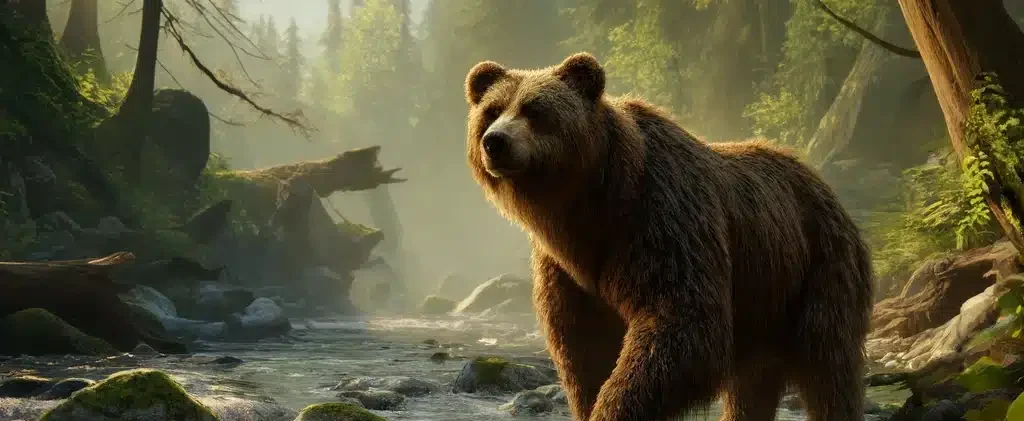
We’re visitors in bear country when we’re out looking for bear prints. It’s super important to be safe and show respect for these amazing animals and their homes.
Stay Safe:
- Make noise while you walk. Sing, clap, or talk loudly. Bears usually avoid people if they hear you coming.
- Carry bear spray and know how to use it. It’s like a fire extinguisher – I hope you never need it, but be glad you have it!
- Travel in groups. More people means more noise and less chance of surprising a bear.
I once felt silly when I heard a loud crash in the bushes. It turned out it was just a squirrel, but I was glad I had my bear spray ready!
Be a Good Guest:
- Don’t leave any trash behind. If you pack it in, pack it out.
- Stay on marked trails when possible. This helps protect bear habitat.
- If you see a bear, give it space. Never try to get closer for a better look or photo.
Teach Others:
- Share your knowledge about bear prints and tracking with friends and family.
- Encourage others to respect and protect bear habitats.
Remember, every time we enter bear country, we’re stepping into their home. Let’s be good guests!
Wrapping It Up
Well, folks, we’ve covered a lot of ground today – just like a bear on a berry-hunting mission! Let’s recap what we’ve learned:
- How to identify bear paw prints
- The differences between black bear, grizzly, and polar bear prints
- How to measure prints and estimate bear size
- Common mistakes to avoid when identifying prints
- How to use prints for tracking
- Safety and conservation in bear country
Learning about bear prints is more than just a cool wilderness skill. It helps us understand these amazing animals better and reminds us how important it is to protect their homes.
Keep your eyes peeled for prints next time you’re out in the woods. You never know what story you might find written in the mud or snow. And remember, every print you find is a little peek into the secret life of bears.
So grab your measuring tape, pack your sense of adventure, and hit the trails. A whole world of bear prints is out there just waiting to be discovered. Who knows? Maybe you’ll be the one to spot the next record-breaking print!
Stay safe, have fun, and happy tracking!
P.S. Don’t forget to share your bear print findings with your fellow nature enthusiasts. There’s nothing quite like the excitement of showing off your first perfectly measured bear print photo!

